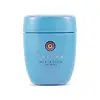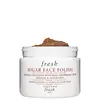What's inside
What's inside
 Key Ingredients
Key Ingredients

 Benefits
Benefits

 Concerns
Concerns

 Ingredients Side-by-side
Ingredients Side-by-side

Microcrystalline Cellulose
AbsorbentOryza Sativa Powder
Sodium Lauryl Phosphate
EmulsifyingSodium Lauroyl Glutamate
Sodium Stearoyl Glutamate
CleansingWater
Skin ConditioningSodium Cocoyl Glutamate
CleansingLauryl Betaine
CleansingSodium Lauroyl Methylaminopropionate
CleansingCamellia Sinensis Leaf
PerfumingPolygonum Tinctorium Leaf/Stem Extract
Skin ConditioningIndigofera Tinctoria Leaf Extract
Skin ConditioningColloidal Oatmeal
AbsorbentHydrolyzed Conchiolin Protein
Skin ConditioningOryza Sativa Bran Extract
Skin ConditioningPropanediol
SolventEthylhexylglycerin
Skin ConditioningButylene Glycol
HumectantPhytosteryl/Octyldodecyl Lauroyl Glutamate
Skin ConditioningTocopherol
AntioxidantAlcohol
AntimicrobialPhenoxyethanol
PreservativeCI 77891
Cosmetic ColorantMica
Cosmetic ColorantMicrocrystalline Cellulose, Oryza Sativa Powder, Sodium Lauryl Phosphate, Sodium Lauroyl Glutamate, Sodium Stearoyl Glutamate, Water, Sodium Cocoyl Glutamate, Lauryl Betaine, Sodium Lauroyl Methylaminopropionate, Camellia Sinensis Leaf, Polygonum Tinctorium Leaf/Stem Extract, Indigofera Tinctoria Leaf Extract, Colloidal Oatmeal, Hydrolyzed Conchiolin Protein, Oryza Sativa Bran Extract, Propanediol, Ethylhexylglycerin, Butylene Glycol, Phytosteryl/Octyldodecyl Lauroyl Glutamate, Tocopherol, Alcohol, Phenoxyethanol, CI 77891, Mica
Sucrose
HumectantPropylene Glycol Dicaprylate/Dicaprate
EmollientPEG-7 Glyceryl Cocoate
EmulsifyingStearalkonium Hectorite
Gel FormingFragaria Vesca Fruit Extract
AstringentEuphorbia Cerifera Wax
Mangifera Indica Seed Butter
Skin ConditioningPropylene Carbonate
SolventParfum
MaskingLimonene
PerfumingLimnanthes Alba Seed Oil
Skin ConditioningVitis Vinifera Seed Oil
EmollientPrunus Domestica Seed Oil
Skin ConditioningFructose
HumectantGlucose
HumectantTocopheryl Acetate
AntioxidantCaramel
Cosmetic ColorantGlycerin
HumectantWater
Skin ConditioningPotassium Sorbate
PreservativeBHT
AntioxidantCitral
PerfumingSucrose, Propylene Glycol Dicaprylate/Dicaprate, PEG-7 Glyceryl Cocoate, Stearalkonium Hectorite, Fragaria Vesca Fruit Extract, Euphorbia Cerifera Wax, Mangifera Indica Seed Butter, Propylene Carbonate, Parfum, Limonene, Limnanthes Alba Seed Oil, Vitis Vinifera Seed Oil, Prunus Domestica Seed Oil, Fructose, Glucose, Tocopheryl Acetate, Caramel, Glycerin, Water, Potassium Sorbate, BHT, Citral
 Reviews
Reviews

Alternatives
Ingredients Explained
These ingredients are found in both products.
Ingredients higher up in an ingredient list are typically present in a larger amount.
Water. It's the most common cosmetic ingredient of all. You'll usually see it at the top of ingredient lists, meaning that it makes up the largest part of the product.
So why is it so popular? Water most often acts as a solvent - this means that it helps dissolve other ingredients into the formulation.
You'll also recognize water as that liquid we all need to stay alive. If you see this, drink a glass of water. Stay hydrated!
Learn more about Water